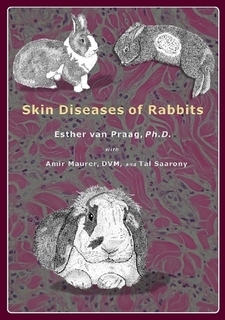Moist
dermatitis, green fur syndrome, caused by
Pseudomonas
aeruginosa
Esther van Praag, Ph.D.
- Oversettelse av Camilla Bergstrøm
|
MediRabbit.com is funded solely by the
generosity of donors. Every donation, no matter what the size, is appreciated and will aid
in the continuing research of medical care and health of rabbits. Thank
you |
|
Fuktig dermatitt eller ”green fur syndrome”
forårsakes av bakterien Pseudomonas aeruginosa. Det observeres av og til hos
kaniner som har jevnlig kontakt med fuktighet, eller som sikler. De
kroppsdelene som er mest utsatt for denne bakterien er hakepose/bryst og buk.
Feil type vannskål eller vannflaske kan forårsake fuktig dermatitt, men som
oftest er denne sykdommen relatert til tannproblemer som gjør at kaninen
sikler. Exudative (relating to the oozing of fluid and other
materials from cells and tissues) moist dermatitis is mainly observed in
rabbits exposed to constant moisture, for instance: • Leaking
water bottles, or inadequate crock; • Overweight; • Large
dewlap (fold of skin which hangs under the throat of female rabbits); • Ptyalism, due to
(severe) dental problems, leading to excessive production of saliva.
Kliniske tegn
Pelsen
blir blågrønn pga at Pseudomonas bakterien frigjør et blått fargepigment som heter
pyocyanin. Huden blir rød og fuktig. Hvis tilstanden ikke blir behandlet i
tide kan det oppstå sekundære bakterieinfeksjoner med abscessdannelser. De
kliniske tegnene er tilstrekkelig for en diagnose. Uansett er en prøve av
bakteriekulturen å anbefale for sikkerhetsskyld. Even so, a bacterial culture is
advisable, as a precautionary measure. The cultures of isolated bacteria will
nevertheless help a proper identification of the bacterium. Sensitivity tests
will furthermore help determine the most efficacious antibiotic. The
bacterium is indeed difficult to treat, as it has naturally acquired
resistance to many antibiotics, while living in the soil, among bacteria,
yeast and fungi that secrete natural antibiotics. Parts of the body
affected by this bacterium are the dewlap, and the abdomen. Lesions are
localized and diffuse and the skin is erythematous and moist. It may be
accompanied by the presence of deep ulcers or abscesses. Secondary bacterial
infection is possible when the condition is left untreated, with the
formation of skin abscesses.
Behandling
Pelsen
rundt det rammede området klippes forsiktig, og den betente huden behandles
med antibiotikasalve. Hvis Pseudomonas spp infeksjonen er alvorlig bør behandlingen
avsluttes med en aggressiv oral antibiotikakur. The
most effective antibiotics remain fluoroquinolone (e.g. enrofloxacin),
gentamycin, and amikacin. Since some strains are resistant to several
antibiotics, a culture accompanied by an antibiotic sensitivity test should
be done. Det anbefales på det sterkeste å
sjekke tennene grundig for å oppdage eventuell feilstilling av fortennene
(malokklusjon), tagger/utvekster på jekslene, og tannrotabscesser. Hvis
tennene er i god stand bør andre muligheter overveies: • Meticulous
inspection of the teeth of the rabbit, in order to detect defects of the
incisors (malocclusion), the presence of spurs or of a tooth root abscess; • Kaninens
drikkevaner bør sjekkes (uansett om kaninen drikker av skål eller flaske). • Vannet
kaninen drikker bør analyseres for å finne ut om det inneholder Pseudomonas
spp. Infections
should not be neglected and left untreated. After the primary invasion of the
skin, Pseudomonas bacteria tend to invade the tissues deeper and will use
the circulatory blood system to disseminate throughout the body.
Takk til…
Thanks are due to Dr. M. Schoenbaum (Ministry of Agriculture, Veterinary Services,
Israel) for the permission to use their pictures. Videre
informasjon
Garibaldi BA, Fox JG, Musto DR.
Atypical moist dermatitis in rabbits. Lab Anim Sci. 1990
Nov;40(6):652-3. O'Donoghue PN, Whatley BF. Pseudomonas aeruginosa in rabbit fur. Lab Anim. 1971
Oct;5(2):251-5. Schoenbaum M. Pseudomonas
aeruginosa in rabbit fur. Lab Anim. 1981 Jan;15(1):5. Wellisch G, Cohen E, Cahane Z, Kedar
S, Fradis M, Podoshin L. Distribution of Pseudomonas aeruginosa
serotypes in Israel. Microbiol Immunol. 1980;24(3):233-35. Williams CS, Gibson RB. Sore dewlap: Pseudomonas aeruginosa
on rabbit fur and skin. Vet
Med Small Anim Clin. 1975 Aug;70(8):954-5. |
e-mail: info@medirabbit.com









